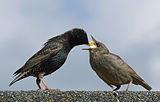List of feeding behaviours — Feeding is the process by which organisms, typically animals, obtain food. Terminology often uses either the suffix vore from Latin vorare, meaning to devour , or phagy, from Greek φαγειν, meaning to eat . Mosquito drinking blood … Wikipedia
Cannibalism — For non human cannibalism, see Cannibalism (zoology). For other uses, see Cannibal (disambiguation). Cannibalism, Brazil. Engraving by Theodor de Bry for Hans Staden s account of his 1557 captivity … Wikipedia
Carnivore — Carnivorism redirects here. For the diet, see No carbohydrate diet. For other uses, see Carnivore (disambiguation). Lions are voracious carnivores; they require up to seven kilograms (15 lbs) of meat per day. A major component of their diet is… … Wikipedia
Coprophagia — A female Oriental Latrine Fly (Chrysomya megacephala) feeds on animal feces. Coprophagia or coprophagy is the consumption of feces, from the Greek κόπρος copros ( feces ) and φαγεῖν phagein ( to eat ). Many animal species practice coprophagia as… … Wikipedia
Geophagy — The red and green macaw eats clay from exposed riverbanks, allowing it to utilize nutrients in harmful foods. Geophagy is the practice of eating earthy or soil like substances such as clay, and chalk. It exists in animals in the wild and also in… … Wikipedia
Predation — For alternative meanings of predator and prey, see Predator (disambiguation) and Prey (disambiguation). Predating can also mean dating earlier than : see wiktionary:predate. Indian Python swallowing a small Chital deer at Mudumalai National Park … Wikipedia
Heterotroph — Overview of cycle between autotrophs and heterotrophs A heterotroph (English pronunciation: /ˈhɛtərɵtroʊf/; ἕτερος heteros = another , different and τροφή trophe = nutrition ) is an organism that cannot … Wikipedia
Omnivore — Ravens are omnivores. Omnivores (from Latin: omni all, everything; vorare to devour) are species that eat both plants and animals as their primary food source. They are opportunistic, general feeders not specifically adapted to eat and digest… … Wikipedia
Kleptoparasitism — Great Frigatebirds chasing a Red footed Booby in order to steal its food. Kleptoparasitism or cleptoparasitism (literally, parasitism by theft) is a form of feeding in which one animal takes prey or other food from another that has caught,… … Wikipedia
Decomposer — For the Matches album of the same name, see Decomposer (album). The fungi on this tree are decomposers Decomposers (or saprotrophs) are organisms that break down dead or decaying organisms, and in doing so carry out the natural process of… … Wikipedia

